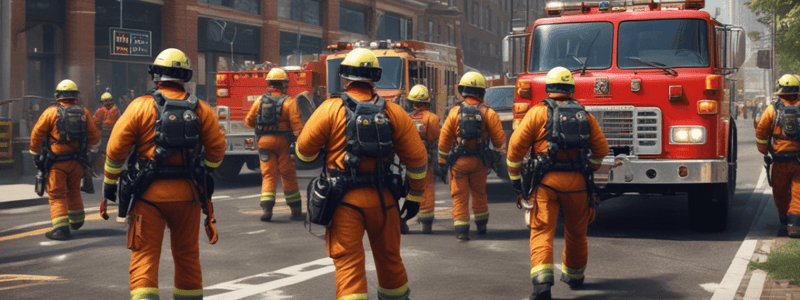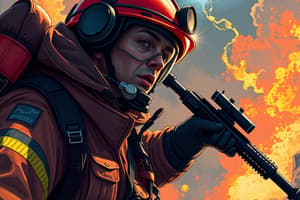Podcast
Questions and Answers
What is the primary purpose of this appendix?
What is the primary purpose of this appendix?
- To provide direction for first responding personnel during technical rescue incidents (correct)
- To detail the training requirements for personnel responding to technical rescue incidents
- To provide a standard operational guideline for technical rescue personnel
- To outline the procedures for members of the Technical Rescue Team during incidents
Which of the following statements is NOT true according to the text?
Which of the following statements is NOT true according to the text?
- Technical rescue incidents are beyond the scope of practice for most fire/rescue personnel
- First responders can provide critical assistance and speed up the intervention process
- The appendix is applicable to MCFRS personnel and other organizations operating in Montgomery County
- The appendix prescribes how members of the Technical Rescue Team will operate during incidents (correct)
What is the intent of this appendix, according to the text?
What is the intent of this appendix, according to the text?
- To provide personnel with a general framework for approaching technical rescue incidents
- To reduce the time frame from when technical rescue assets arrive and when they enter to execute the rescue
- To provide a framework for a risk/benefit analysis during technical rescue incidents
- All of the above (correct)
What is the source of information used in developing this appendix?
What is the source of information used in developing this appendix?
What is the scope of technical rescue incidents mentioned in the text?
What is the scope of technical rescue incidents mentioned in the text?
Which of the following statements is true based on the information provided in the text?
Which of the following statements is true based on the information provided in the text?
According to the checklists provided, which of the following is NOT one of the initial actions for first responders in a rope rescue scenario?
According to the checklists provided, which of the following is NOT one of the initial actions for first responders in a rope rescue scenario?
In a structural collapse scenario, what is the minimum recommended distance for establishing a staging area if the structure is over four stories tall?
In a structural collapse scenario, what is the minimum recommended distance for establishing a staging area if the structure is over four stories tall?
Which of the following is NOT listed as a potential hazard that should be identified in a structural collapse scenario?
Which of the following is NOT listed as a potential hazard that should be identified in a structural collapse scenario?
In a confined space rescue scenario, what is the FIRST action that should be taken by first responders according to the checklist?
In a confined space rescue scenario, what is the FIRST action that should be taken by first responders according to the checklist?
In a rope rescue scenario, what is the maximum angle at which first responders are allowed to perform rescues using rope systems and stokes basket evolutions?
In a rope rescue scenario, what is the maximum angle at which first responders are allowed to perform rescues using rope systems and stokes basket evolutions?
According to the checklists, what action should first responders take to support self-rescue in a confined space scenario?
According to the checklists, what action should first responders take to support self-rescue in a confined space scenario?
According to the policy, which statement is true regarding personnel performing tasks above their certification level?
According to the policy, which statement is true regarding personnel performing tasks above their certification level?
If a checklist exists for a given incident type, what is the policy regarding its use?
If a checklist exists for a given incident type, what is the policy regarding its use?
Who has the authority to update the technical rescue incident checklists?
Who has the authority to update the technical rescue incident checklists?
In the case of a trench incident, what is the minimum distance for the hot zone from the trench?
In the case of a trench incident, what is the minimum distance for the hot zone from the trench?
For a structural collapse involving a structure four stories or greater, what is the minimum hot zone distance specified in the policy?
For a structural collapse involving a structure four stories or greater, what is the minimum hot zone distance specified in the policy?
Under what conditions are first responder personnel allowed to enter a trench?
Under what conditions are first responder personnel allowed to enter a trench?
What is the policy regarding the use of aerial tower apparatus for rope systems intended for a two-person load?
What is the policy regarding the use of aerial tower apparatus for rope systems intended for a two-person load?
What is the requirement for travel restriction or fall arresting systems when operating within 10 feet of an exposed area with a fall risk greater than 6 feet?
What is the requirement for travel restriction or fall arresting systems when operating within 10 feet of an exposed area with a fall risk greater than 6 feet?
According to the policy, when can first responder personnel enter a collapsed structure?
According to the policy, when can first responder personnel enter a collapsed structure?
What is the responsibility of the first arriving Primary Unit Officer, according to the policy?
What is the responsibility of the first arriving Primary Unit Officer, according to the policy?
What is the primary reason that technical rescue incidents are considered high-risk, low-frequency events?
What is the primary reason that technical rescue incidents are considered high-risk, low-frequency events?
According to the passage, which of the following is NOT one of the four basic types of technical rescue incidents?
According to the passage, which of the following is NOT one of the four basic types of technical rescue incidents?
What is the primary reason that the fastest way to rescue and/or evacuate the victim(s) may not be the safest way to do so during a technical rescue incident?
What is the primary reason that the fastest way to rescue and/or evacuate the victim(s) may not be the safest way to do so during a technical rescue incident?
According to the passage, which of the following is NOT one of the four common objectives for all technical rescue incidents?
According to the passage, which of the following is NOT one of the four common objectives for all technical rescue incidents?
What is the primary reason that the standard fire/rescue three-gas meter configuration is insufficient for technical rescue incidents?
What is the primary reason that the standard fire/rescue three-gas meter configuration is insufficient for technical rescue incidents?
What is the primary purpose of establishing an Incident Commander during a technical rescue incident?
What is the primary purpose of establishing an Incident Commander during a technical rescue incident?
According to the passage, what is the primary reason that personnel should support the victim(s)' self-rescue whenever possible during a technical rescue incident?
According to the passage, what is the primary reason that personnel should support the victim(s)' self-rescue whenever possible during a technical rescue incident?
What is the primary reason that time spent in scene preparation and hazard control is rarely wasted during a technical rescue incident?
What is the primary reason that time spent in scene preparation and hazard control is rarely wasted during a technical rescue incident?
What is the primary reason that some structural and trench collapses may require custom engineering solutions?
What is the primary reason that some structural and trench collapses may require custom engineering solutions?
According to the passage, what is the primary purpose of identifying and marking Isolation Zones during a technical rescue incident?
According to the passage, what is the primary purpose of identifying and marking Isolation Zones during a technical rescue incident?
What is the primary responsibility of personnel when responding to a confined space rescue incident?
What is the primary responsibility of personnel when responding to a confined space rescue incident?
What is the primary purpose of establishing staging areas at least 250 feet away from the incident scene?
What is the primary purpose of establishing staging areas at least 250 feet away from the incident scene?
What is the primary role of the Rescue Squad when responding to a technical rescue incident?
What is the primary role of the Rescue Squad when responding to a technical rescue incident?
What is the primary responsibility of the Aerial unit when responding to a technical rescue incident?
What is the primary responsibility of the Aerial unit when responding to a technical rescue incident?
What is the primary responsibility of the Engine unit when responding to a technical rescue incident?
What is the primary responsibility of the Engine unit when responding to a technical rescue incident?
What is the primary purpose of the Situation Update Report (SUR) in a technical rescue incident?
What is the primary purpose of the Situation Update Report (SUR) in a technical rescue incident?
What is the primary purpose of the Initial On-Scene Report (IOSR) in a technical rescue incident?
What is the primary purpose of the Initial On-Scene Report (IOSR) in a technical rescue incident?
What is the primary reason for the presence of known chemical hazards at a technical rescue incident?
What is the primary reason for the presence of known chemical hazards at a technical rescue incident?
What is the primary purpose of the checklists referenced in the policy?
What is the primary purpose of the checklists referenced in the policy?
What is the primary responsibility of personnel when responding to a trench collapse incident?
What is the primary responsibility of personnel when responding to a trench collapse incident?
Flashcards are hidden until you start studying




